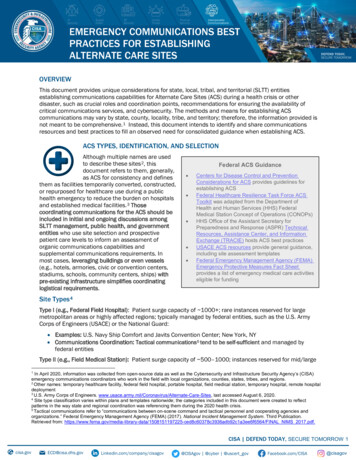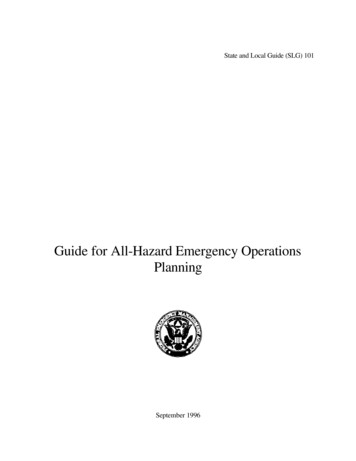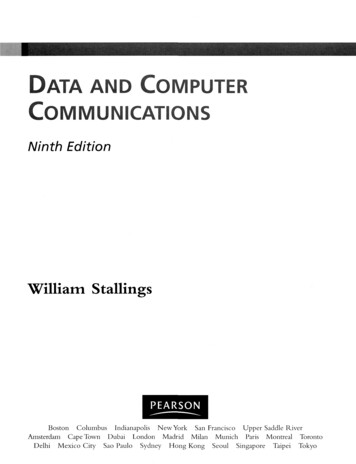
Transcription
Emergency Communications Best Practices for Establishing Alternate Care SitesEMERGENCY COMMUNICATIONS BESTPRACTICES FOR ESTABLISHINGALTERNATE CARE SITESOVERVIEWThis document provides unique considerations for state, local, tribal, and territorial (SLTT) entitiesestablishing communications capabilities for Alternate Care Sites (ACS) during a health crisis or otherdisaster, such as crucial roles and coordination points, recommendations for ensuring the availability ofcritical communications services, and cybersecurity. The methods and means for establishing ACScommunications may vary by state, county, locality, tribe, and territory; therefore, the information provided isnot meant to be comprehensive. 1 Instead, this document intends to identify and share communicationsresources and best practices to fill an observed need for consolidated guidance when establishing ACS.ACS TYPES, IDENTIFICATION, AND SELECTIONAlthough multiple names are usedto describe these sites 2, thisdocument refers to them, generally,as ACS for consistency and definesthem as facilities temporarily converted, constructed,or repurposed for healthcare use during a publichealth emergency to reduce the burden on hospitalsand established medical facilities. 3 Thosecoordinating communications for the ACS should beincluded in initial and ongoing discussions amongSLTT management, public health, and governmententities who use site selection and prospectivepatient care levels to inform an assessment oforganic communications capabilities andsupplemental communications requirements. Inmost cases, leveraging buildings or even vessels(e.g., hotels, armories, civic or convention centers,stadiums, schools, community centers, ships) withpre-existing infrastructure simplifies coordinatinglogistical requirements.Federal ACS Guidance Centers for Disease Control and PreventionConsiderations for ACS provides guidelines forestablishing ACSFederal Healthcare Resilience Task Force ACSToolkit was adapted from the Department ofHealth and Human Services (HHS) FederalMedical Station Concept of Operations (CONOPs)HHS Office of the Assistant Secretary forPreparedness and Response (ASPR) TechnicalResources, Assistance Center, and InformationExchange (TRACIE) hosts ACS best practicesUSACE ACS resources provide general guidance,including site assessment templatesFederal Emergency Management Agency (FEMA)Emergency Protective Measures Fact Sheetprovides a list of emergency medical care activitieseligible for fundingSite Types 4Type I (e.g., Federal Field Hospital): Patient surge capacity of 1000 ; rare instances reserved for largemetropolitan areas or highly affected regions; typically managed by federal entities, such as the U.S. ArmyCorps of Engineers (USACE) or the National Guard: Examples: U.S. Navy Ship Comfort and Javits Convention Center; New York, NY Communications Coordination: Tactical communications 5 tend to be self-sufficient and managed byfederal entitiesType II (e.g., Field Medical Station): Patient surge capacity of 500–1000; instances reserved for mid/large1In April 2020, information was collected from open-source data as well as the Cybersecurity and Infrastructure Security Agency’s (CISA)emergency communications coordinators who work in the field with local organizations, counties, states, tribes, and regions.2Other names: temporary healthcare facility, federal field hospital, portable hospital, field medical station, temporary hospital, remote hospitaldeployment3U.S. Army Corps of Engineers. s, last accessed August 6, 2020.4Site type classification varies within plans and templates nationwide; the categories included in this document were created to reflectpatterns in the way state and regional coordination was referencing them during the 2020 health crisis.5Tactical communications refer to “communications between on-scene command and tactical personnel and cooperating agencies andorganizations.” Federal Emergency Management Agency (FEMA) (2017). National Incident Management System. Third Publication.Retrieved from: 225-ced8c60378c3936adb92c1a3ee6f6564/FINAL NIMS 2017.pdf.CISA DEFEND TODAY, SECURE TOMORROW gov@CISAgov @cyber @uscert govFacebook.com/CISA@cisagov
Commercial Routing AssistanceEmergency Communications Best Practices for Establishing Alternate Care Sitesurban/suburban areas or highly affected regions; often federally sponsored and supported, but executedthrough the state: Example: New Jersey Convention Center; Edison, NJ Communications Coordination: State-assisted telecommunications coordination with potential supportfrom federal entities (e.g., survey, site selection, gap analysis); SLTT governments work with federalentities, such as the Federal Emergency Management Agency (FEMA), as required, to secure fundingfor their communications needsType III (e.g., Local ACS) 6: Patient surge capacity of 500 or less; often deployed in smaller urban areas andsuburban or rural communities; may be initiated by SLTT governments: Examples: Connecticut Task Force, appointed by the Governor, site assessments for ACS performedthroughout the state (March 2020); Multiple Sites, CT Communications Coordination: SLTT governments may work in coordination with a federal entity toassist in site identification and often self-assess, deploy, and demobilize communications needswithout further need for supplemental provision or managementCOORDINATING AND OPERATIONALIZING SUCCESSFUL ACS COMMUNICATIONSEarly coordination and a better understanding of the longterm mission help define appropriate communicationsrequirements from the beginning. Communicationscoordinators increase their likelihood of success by1) leveraging existing plans; 2) knowing key points ofcoordination (both government and industry);3) performing on-site assessments to anticipateimmediate and long-term communications requirements;4) knowing how to prioritize ACS services; and5) identifying infrastructure and cybersecurityrequirements and who will address those needs. Thefollowing sections provide additional information onfollowing these best practices throughout ACS deploymentand demobilization/decontamination.Plans, Tools, and TemplatesLeveraging well-thought out guidance andtemplates can assist in the development ofprescriptive ACS response plans. Whether facedwith having to quickly establish an ACS without apre-existing plan or building a plan during noncrisis times, the HHS ASPR TRACIE portalprovides relevant resources and technical tools on: Site Selection Matrices SLTT Toolkits to Assist with Establishing ACS ACS Decision Frameworks ACS Lifecycle Concepts, Models, andProcess Flowcharts ACS Sample Plans and TemplatesLeveraging, Executing, and Revising Existing PlansIdeally, local or county governments considering deploying ACS have already written,employed, and exercised a CONOPs, or other operational plan, in coordination with theirlocal, county, and state health departments that includes ACS considerations for whenhospitals are overwhelmed. Often referred to as an ACS CONOPs Plan, this document notonly considers unique characteristics of the area to properly identify and select a sitelocation, provide adequate staffing and supply levels, and streamline operations, but reflectslogistics and coordination communications and Information Technology (IT) requirementsunique to a public health crisis. Information within an ACS CONOPs plan may include, but isnot limited to, potential event scenarios; surge response levels (including state or federal assistance or StateMedical Response Team support); site types determined by scenario types; scope of patient care (level andtype); site potentials and physical characteristics based on pre-event site assessments (e.g., location, size,layout, infrastructure and capabilities, security); population demographics and social vulnerabilities to thearea; staffing recruitment and training needs; credentialing and patient-tracking processes; logisticsoperations and support (e.g., supply chain and equipment/support provision); site activation and supportsequence; patient transportation needs; demobilization processes, and key points of contact.Healthcare requirements during health crises are often unpredictable, potentially requiring those executingthe plan to adapt operations as the event unfolds. Lessons learned should be recorded at various executionstages to ensure data on successes and challenges are documented and incorporated back into the planfollowing the event.6There is a greater need to provide best practices and guidance to smaller ACS as the communities standing up these facilities often drawfrom limited resources, require additional coordination with federal entities and service providers to supplement coverage in ad hoc ways,and are less likely to have recently updated and exercised CONOPs or operational plans across the community.CISA DEFEND TODAY, SECURE TOMORROW gov@CISAgov @cyber @uscert govFacebook.com/CISA@cisagov
Commercial Routing AssistanceEmergency Communications Best Practices for Establishing Alternate Care SitesKey Roles and Sources of CoordinationEven in the wake of a major public health crisis, responseefforts start at the community level. In almost every case,deploying ACS requires coordination across variousinstitutions, disciplines, levels of government, and industrystarting at the local or county levels to identify need,sponsors, patient care, facility requirements, and potentialsites. Ideally, a Unified Command, as defined in the IncidentCommand System (ICS) 7, will assist coordinatingcommunications aspects of the public health crisis acrossjurisdictions, including ACS activation.Roles of Communication Unit Leaders (COMLs) andInformation Technology Service Unit Leaders (ITSL) forCoordinating ACSCOML Areas of ExpertiseTo inform response and ACS deploymentduring a health crisis or other disaster, COMLsoften have critical knowledge of: Local communications and systems Frequencies and spectrum Patching technologies Local topography System site locations SLTT communications plans Regional and local Tactical InteroperableCommunications Plans, if available Communications and resource contacts ICS 300 level trainingCOMLs and ITSLs bring value to ACS communicationscoordination and deployment and should be involved in coordinating ACS communications, when possible. Aposition within the ICS, COMLs develop plans for effective incident communications equipment and facilitiesuse, manage communication equipment distribution, and coordinate installation and testing. A COMLdetermines the appropriate communications requirements, including programming and deploying radios as wellas mitigating interference. In many cases of local or county communications coordination for ACS, COMLs canconduct site assessments to identify communications capabilities, define the communications requirements,determine gaps, and coordinate deployment and demobilization of support and assets.The ITSL has knowledge and expertise in IT, and is needed to provide information management, wired andwireless network requirements, cybersecurity, and application management in response to incidents, includingIncident/Unified Command Post, Incident Communications Centers, Medical Control Operations Centers andvarious tactical operations centers, joint information center (JIC), staging areas, and field locations. The ITSL isable to fulfill critical needs for sufficient access to broadband data, applications, and systems for ACS. 8Other Key Coordination PointsEmergency communications personnel from the local or county EmergencyOperations Center (EOC) should consider maintaining regular contact with thefollowing key personnel across all levels of government and betweenemergency management and healthcare entities to properly coordinate siteselection, conduct assessments, develop requirements, and assist theoperationalization and demobilization stages of ACS deployment: State EOC Emergency Support Function (ESF)-2Lead ESF-8 Lead Statewide Interoperability Coordinator(SWIC) FEMA Regional Administrators Department of Health and HumanServices (HHS) Regional Administrators Emergency MedicalServices (EMS)Administrators andMedical Directors Hospital Medical Directors and Administrators ACS Operations Manager(s) Communications Industry/Private Sector Leads Cybersecurity and Infrastructure Security Agency(CISA)’s Regional Directors7In incidents involving multiple jurisdictions, a single jurisdiction with multiagency involvement, or multiple jurisdictions with multiagencyinvolvement, Unified Command allows agencies with different legal, geographic, and functional authorities and responsibilities to worktogether effectively without affecting individual agency authority, responsibility, or accountability.8Depending on how the ACS is used, COMLs and ITSLs may coordinate with SLTT public safety entities—potentially including EMS, 911Centers or Public Safety Answering Points (PSAPs), and Emergency Communications Centers (ECCs)—to integrate new ACScommunications capabilities and requirements into existing response and hospital transport plans. Inclusive staffing of critical personnelensures the ACS is effective when establishing necessary capabilities, such as EMS patient transport communications or dispatch needs.CISA DEFEND TODAY, SECURE TOMORROW gov@CISAgov @cyber @uscert govFacebook.com/CISA@cisagov
Commercial Routing AssistanceEmergency Communications Best Practices for Establishing Alternate Care SitesInformation Sharing Platforms during Health CrisesCoordinating entities should use shared and trusted platforms as much as possible to exchange crucialinformation during public health crises. 9 The following may be used to support critical information exchangeduring an event, ranging from cleared public information to information and coordination exchange relevant forincident and crisis management for ACS:information systems to support Centers for Disease Control andpatient-centered carePrevention (CDC)’s Health Alert Network Homeland Security Information NetworkProvides cleared, public healthinformation alertsShares sensitive but unclassified HHS Health Information Exchangeinformation among the Department ofSupports secure exchange of clinicalHomeland Security’s (DHS) federal,information among differentSLTT, and international partnersMeeting ACS Mission Requirements: Assessments, Gap Analyses, and Resource DeploymentFollowing site selection, communications coordinators will need to reference existing plansand coordinate closely with the ACS Operations Manager to determine communicationsrequirements. Next, an assessment will need to be performed of the site’s existingcapabilities as well as a gap analysis to identify the need for and availability of auxiliarycapabilities and services. The following list is not comprehensive, but it may assist withinitial steps to generate ACS communications requirements; achieve operable,interoperable, reliable, resilient, and secure ACS voice, video, and data needs; andmitigate disruptions to or shifts in service and capabilities.Meeting ACS Mission Requirements during Site Identification, Selection 10, and DeploymentCommunications coordinators should be included when identifying sites, determining opportunities to leverageexisting infrastructure, and identifying additional need to meet coverage, capacity, coordination, andinteroperability requirements: ACS type and scope of communications, including number and composition of coordinating entities (e.g.,federal, SLTT)ACS configuration (i.e., for central ACS, consider needs for supplemental coverage; for multiple ACSthroughout the area, consider interoperability needs of multiple systems across sponsor hospital andauxiliary sites)Scope of patient care, such as transient care (testing) or permanent (beds) and number being treated,potential duration of stay, and other factors influencing care (e.g., global vs. geographically-confined event;acute vs. non-acute care)Site characteristics, such as proximity to the sponsor hospital, size, configuration (e.g., placement/proximityof logistics offices to ACS dispatch or nursing subunits), accessibility, existing infrastructure, and layoutACS staffing requirements, such as communications methods and need for training and orientation oncommunications equipment use and proceduresIntegrated facility systems (e.g., power; heating, ventilation, and air conditioning; building security, cameras,and locking systems; sprinklers and alarms; generators)Patient transportation services (e.g., EMS, transportation services to/from sponsoring hospital or other ACS)On-site dispatch and operator servicesOn-site security services or law enforcement presenceIT and requirements for secure information and data entrance, storage, and transfer (e.g., patient,healthcare, and diagnostic portals; telemedicine; video teleconferencing)Communications providers and protocols (early consultation to meet mission requirements)States and localities are using a variety of platforms to coordinate resources and share information. For instance, 911, PSAPs, and ECCsmay use Computer Aided Dispatch (CAD) systems to coordinate law enforcement, fire, and EMS resources and response. Also, in largemetropolitan areas, EMS may employ city, county, or region-wide hospital status systems that may integrate with the CAD to indicate thestatus of a hospital, or services/capabilities of that hospital and their present status.10Site identification is the process of identifying potential sites whereas selection processes require a comparison across options to choosethe most appropriate facility to meet ACS mission requirements, including communications.9CISA DEFEND TODAY, SECURE TOMORROW gov@CISAgov @cyber @uscert govFacebook.com/CISA@cisagov
Commercial Routing AssistanceEmergency Communications Best Practices for Establishing Alternate Care SitesACS communications should meet nationwide emergency communications standards, with considerations forhow to successfully plan for and deploy operable, interoperable, reliable, resilient, secure, scalable, andredundant capabilities and systems. 11 Following a determination of ACS requirements, communicationscoordinators should assess existing ACS communications and IT infrastructure, coverage, and capabilities forvoice, video, and data to meet mission needs.OperabilityAbility to provide and maintainreliable communicationsfunctionality throughout the area ofresponsibilityInteroperabilityAbility of emergency responseproviders and relevant governmentofficials to communicate acrossjurisdictions, disciplines, and levelsof government as needed and asauthorizedReliabilityAbility to function in any type ofincident, regardless of cause, size,location, or complexityResiliencyAbility to perform despite damagedor lost infrastructureSecurityIncorporating data, network, andsystems protection best practicesinto incident communications anddata sharing in compliance withdata protection and privacy laws 11If there are gaps in coverage or capabilities, communications coordinatorsshould reach to their communications equipment and technologyreserves, mutual aid partners, service providers and vendors, and thestate or territory to supplement coverage and capacity for ACS voice,video, and data needs. If the ACS is in a remote or rural area or publicsafety resources are unable to supplement coverage, coordinatingentities may need to deploy transportable solutions (e.g., cell-on-wheels,cell-on-light-truck, man-portable cellular systems). When selecting anddeploying solutions to support or augment the network, coordinatingentities should consider necessary requirements for range ofcommunications reception, configuration set-up to accommodateanticipated number of simultaneous users, necessary primary and backup power sources (e.g., primary source and back-up generators),processes for adding mobile devices to the network, needs for additionalequipment, and the size and placement of the deployable device. In somecircumstances, federal assistance is available to states, territories, andtribes through the FEMA’s Disaster Emergency Communications (DEC)Mobile Emergency Response Support (MERS).ACS systems will also need preemption and prioritization to ensure thatthe site’s vital voice, video, and data circuits and othertelecommunications services receive priority treatment and are able toconnect. Priority Telecommunications Services (PTS) provide essentialprovisioning for ACS requiring installation of new services. Moreinformation on how to request installation or restoration of services fordeploying initial ACS capabilities is provided on Page 7.In addition to ensuring ACS communications interoperate with thesponsoring hospital’s systems and/or patient/hospital portals,considerations need to be made for securely entering, storing, andtransferring sensitive information. Those coordinating ACScommunications should work with IT and security personnel, such as theITSL, to incorporate data (e.g., patient data, personally identifiableinformation, e-personal health information), network, and systemsprotection best practices and compliance with data protection and privacylaws, such as the 1996 Health Insurance Portability and AccountabilityAct (often referred to as HIPAA). Considerations should be made todetermine who will implement and manage secure ACS system and datatransfer. Cybersecurity resources for ACS systems needed to support dataentry, storage, and transfer are on Page 8.Interacting with Service Providers when Planning Communications for the ACSConfirm the service provider of the chosen facility immediately following site identification to assess the facility’scapabilities and coordinate service augmentation to meet ACS communications requirements; identify service gaps andcoordinate additional coverage options with the vendor point of contactLeverage pre-existing relationships with service providers and vendors and keep close coordination with them on theneed to prioritize restoration and provisioning services for the facilityDetermine vulnerabilities to capabilities and confirm contingency plans and support for redundant systems with vendorsFEMA’s National Incident Management System (NIMS) has established these as standard communications system features.CISA DEFEND TODAY, SECURE TOMORROW gov@CISAgov @cyber @uscert govFacebook.com/CISA@cisagov
Commercial Routing AssistanceEmergency Communications Best Practices for Establishing Alternate Care SitesAnticipating Changes to MissionCommunications should be planned and executed tomeet identified mission requirements with the caveatthat changes in requirements are likely and planningand execution must be agile. Social andenvironmental factors may require the ACS to expandor reduce services, change the mission, or resolveunanticipated disruptions in service. Therefore, thosecoordinating communications should considerchallenges and solutions to ensure the scalability andredundancy of ACS communications systems.Military Sealift Command Hospital Ship USNS Comfort (T-AH20), originally deployed on March 30, 2020, as an overflowhospital for non-COVID patients, was converted to a COVIDtreatment facility shortly after due to changing missionpriorities; however, it was left virtually unused due to theestablishment of the ACS at Javits Convention Center andwas redeployed after three weeks. Credit: U.S. NavyACS Expansion 12 – Initial coordination and siteassessments account for a certain patient capacity. Ifthe area’s patient load suddenly increases, thefacility may need to expand its functional capacityand coverage, assuming space allows.ACS Functional Shift – Health crises and otherdisasters change the way we interact and theExpect the UnexpectedThose coordinating ACS communications shouldactions we take, especially as a result of socialinclude contingencies in ACS deployment plansdistancing and quarantine and isolation policies.to anticipate potential need for scalingThese changes may decrease risky behaviorscommunications, mid-operation, such asamong the masses, potentially reducing the needincreases in bandwidth for one- or two-wayto treat an overflow of non-afflicted patients.telehealth services or video teleconferencingHowever, increased demand for treating afflictedpatients may overwhelm primary-care facilitieswithin a short timeframe, requiring an ACS to treat those affected by the crisis or disaster instead. Shifts intreatment often result in changes to the facility’s function, and thus, its communications requirements.ACS Disruption – Assessments and requirements determination phases should consider strategies for ensuringreliable and redundant ACS communications and service restoration. If the nation is experiencing a health crisisduring, or approaching, a natural hazards season (e.g., floods, inclement weather, fire, hurricane), especially ingeographically susceptible regions, the likelihood of service disruption or outages increases significantly.Reliable and Redundant SystemsWhat happens when the primary ACS communications system goes down? The effectiveness and functionality of thefacility may become compromised, potentially endangering patients and personnel. Therefore, those coordinating andstanding up communications should consider system requirements and redundant capacities, including: Wired telephone capabilitiesCellular capabilitiesTwo-way radiosAmateur radios Deployable sites to add coverage/capacitySatellite telephonesWired data servicesAlternative power systemsCommunications coordinators should revisit and understand existing contingency plans when performing ACSfacility assessments and determining communications requirements, and adapt them, as needed, to account foralternate communications capabilities and procedures in the event of an outage or need for expansion.12Considerations should also be made to potentially reduce ACS operations, and thus communications requirements, if the facility’s actualpatient numbers are significantly under original capacity estimates.CISA DEFEND TODAY, SECURE TOMORROW gov@CISAgov @cyber @uscert govFacebook.com/CISA@cisagov
Commercial Routing AssistanceEmergency Communications Best Practices for Establishing Alternate Care SitesTelecommunications Service Priority ProgramThe Telecommunications Service Priority (TSP) program authorizes national security and emergency preparedness(NS/EP) organizations to receive priority treatment for vital voice and data circuits. The TSP program provides servicevendors a Federal Communications Commission (FCC) mandate to prioritize requests by identifying those servicescritical to NS/EP.There are two primary uses for TSP: provisioning of new services and restoring existing services. TSP provisioningservices are particularly relevant to standing up an ACS as they provide priority installation of new voice and datacircuits. When circumstances require installation of a new telecommunications service faster than a service vendor'snormal processes allow, an organization may request provisioning priority. This can be an immediate installationfollowing an emergency or an installation by a specific date, also known as essential provisioning. These simplifiedsteps show the basic process for requesting provisioning priority:1.2.3.Call the Priority Telecommunications Service (PTS) Center for instructions on how to submit the requestCISA will provide a TSP Authorization Code for each service or circuit to be installed, which will be provided tothe service provider and then given to the service vendorThe vendor will confirm receipt of the TSP Authorization Code(s) with the TSP Program OfficeThose coordinating ACS communications should also check the enrollment of the sponsor hospital and confirmextension of TSP restoration services to its auxiliary facilities. TSP Authorization Codes are valid for three years.The FCC requires all users revalidate their requirement for TSP every three years before expiration. Users should beaware that TSP restoration priorities must be requested and assigned before a service outage occurs.For more information on TSP, please visit the CISA web site at https://www.cisa.gov/tsp or contact the PTS Center tollfree at 866-627-2255, 703-676-2255, or via email at support@priority-info.com.ADDITIONAL CONSIDERATIONS FOR DECONTAMINATION AND DEMOBILIZATIONACS communications operations should consider protocols for cleaning and disinfecting equipment, to includedetailed guidance on frequency and cleaning/disinfecting procedures. Equipment and surfaces should becleaned and disinfected as soon as possible after a known exposure; “high touch” surfaces and issuedhandheld equipment should be cleaned and disinfected before each shift or following each person’s use. Formore information, please refer to CISA’s Guidelines for 911 Centers: Pandemic Cleaning and Disinfecting.In anticipation of a decreased need for ACS as the public health need diminishes, those coordinating,managing, and operating ACS communications should implement a demobilization plan—ideally developed wellin advance of the demobilization phase—including establishing a threshold for when demobilization will occurwith ACS Operations Managers. Once demobilization determination has been made, the following steps shouldbe taken: Ensure equipment is decontaminated in accordance with manufacturer guidelines, CDC guidance, andrecommendations coming out of the United States Environmental Protection Agency regarding cleaningsolutions, application methods, con
Aug 06, 2020 · Resources, Assistance Center, and Information Exchange (TRACIE) hosts ACS best practices USACE ACS resources provide general guidance, including site assessment templates Federal Emergency Management Agency (FEMA) Emergency Protective Measures Fact Sheet provides a list of emergen










